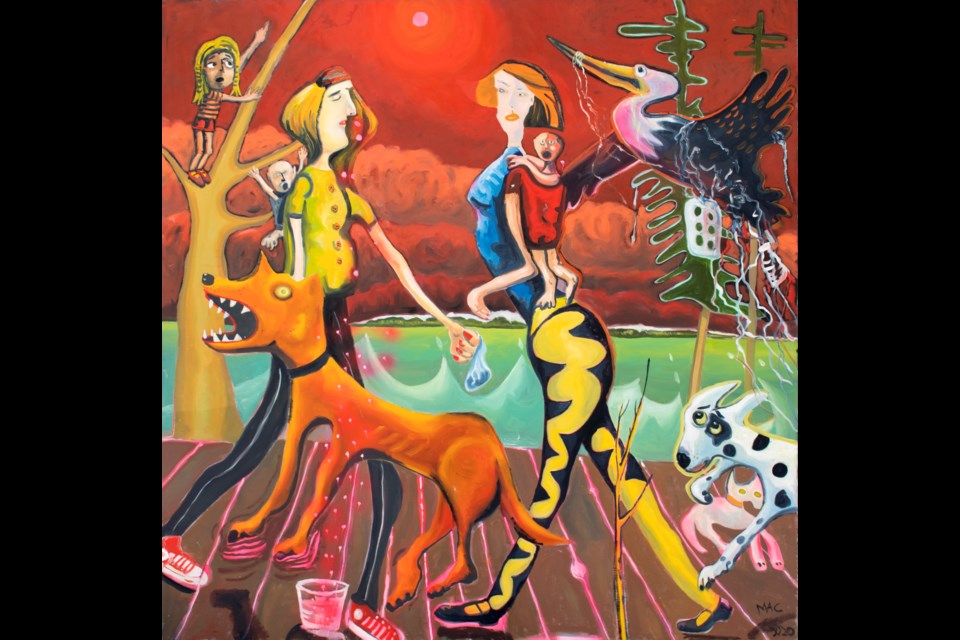CANMORE– Melding science with art, a new progressive exhibit is set to take over Canmore to highlight the need for action in addressing the climate crisis.
The Transitions: Art-science Project on Climate Change exhibit has an opening reception at artsPlace on March 5 at 5:30 p.m.
“We have the ability to discuss as a community what climate change means, what it looks like and how it impacts all of us,” said Canmore's arts and culture coordinator and co-curator Nicky Pacas. “This isn’t just a conversation about climate change— it’s how we understand the facts about it, how we can communicate that and how artwork is a really great medium for communicating ideas."
Transitions is an on-going project between U.K. artist Gennadiy Ivanov, professor John Pomeroy of the University of Saskatchewan and the Canmore Cold Water Laboratory, and professor Trevor Davies of the University of East Anglia in the U.K. with Global Water Futures.
The trio has collaborated in completing fieldwork exploring climate change and the exhibit fuses art and climate science to showcase the results.
“Gennadiy has been travelling with these professors and translating their sound scientific research through artwork," Pacas said. “It gives an artistic visualization of climate change.”
The exhibit was made possible through a partnership between the Town of Canmore, Global Water Futures and artsPlace. The Three Sisters Gallery, the Civic Centre and artsPlace will feature Ivanov’s work along with 20 Bow Valley artists.
Pacas said she is grateful local artists are so willing to engage and participate in the show.
“We feel really lucky,” Pacas said. “They can talk about climate change from their perspective, from their home in their area in a really intimate space.”
Transitions was a great fit for Canmore, she added, because a lot of the landscapes Ivanov has been looking at and learning about are from the Bow Valley area and are featured in his works.
“Canmore seems like a great place to have this conversation as we have a community that is highly engaged with our changing climate,” Pacas said, adding that Transitions became an especially meaningful exhibit to host because Canmore council declared a climate emergency in 2019. “Art has this ability without statistics or words necessary to give us another way of thinking about these things.”
Artist and co-curator Pascale Ouellet said it was important to bring Transitions to Canmore because the town is already seeing the effects of the climate crisis first-hand.
The subject is often a divisive problem that puts people in two camps, she said, where they deny the problem versus those who are extremely concerned about the lasting ramifications.
“It’s not a subject that has a grey shade, it’s black or white,” Ouellet said.
She added she appreciates that pieces will be on display at the Canmore Civic Centre because it is a place of change.
“It’s so relevant that’s where all the decisions are being made,” Ouellet said, explaining that it serves as the perfect reminder to not give up on fighting the climate crisis.
Ouellet said it is exciting to be involved because Bow Valley aritsts have contributed work to the exhibit. She added that she was overwhelmed at the response from the community.
“It’s something everybody wants to be apart of,” Ouellet said. “There’s very exciting art for the show.”
Climate change is an important subject to tackle, Ouellet said, so she took a different approach to creating the show and met and discussed what the subject means to artists and how that could be presented to audiences.
Transitions has proven to be a rewarding creative outlook, Ouellet said, serving as a platform for artists to get together and learn from each other.
“Everybody has something to say and I enjoy that,” Ouellet said. “We have great visuals for the show.”
It is inspiring to hear the artist’s motivation and research behind pieces that will be part of the show, she said, as well as the different perspectives that were taken in the process of creation.
Ouellet added she hopes the show has the potential to return to the town as an annual exhibit because climate change is “a subject that will never grow old.”
“This is a baby step towards something that could become so much bigger,” she said, explaining that she hopes to see the exhibit grow and continue each year.
Art is a universal language, Ouellet added, explaining that anyone can respond to what they see based on their life experience while encouraging people to explore outside their comfort zone.
“It’s a good way to meet and talk about things that we may not want to talk about,” Ouellet said. “Especially for a difficult subject like the climate crisis.”
ArtsPlace program manager Nicole Fougère said Transitions has proven to be a great opportunity to partner with the Town and help an important exhibit “come to life across the community.”
Artists by their very nature are change-makers, she said, and art has a way of touching the deepest parts of identity.
Transitions will help people experience cutting edge science deeply through the unique perspective of art, she said.
Science and art complement each other, Fougère explained, because both are “disciplines of innovations and invite risk-taking and big picture thinking and dreaming,” and the show will embody that principle.
“I hope they [visitors] understand that change needs to happen fast,” Fougère said, adding that she hopes people are inspired to take action and do what is needed to help change their ways to ensure the planet is viable for future generations.
Transitions: Art-science Project on Climate Change runs until April 2.




